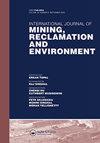基于树的集成模型结合高斯混合模型预测矿区卡车生产能力
IF 2.7
3区 工程技术
Q3 ENVIRONMENTAL SCIENCES
International Journal of Mining Reclamation and Environment
Pub Date : 2022-11-03
DOI:10.1080/17480930.2022.2142425
引用次数: 5
摘要
摘要在过去的十年里,机器学习算法被广泛应用于建立各种采矿应用的预测模型。然而,没有研究报告使用ML算法预测卡车生产率。在本研究中,结合高斯混合建模(GMM),提出了两种基于树的集成学习算法,包括随机森林(RF)和梯度增强回归(GBR),以训练卡车生产率的预测模型。采用GMM作为聚类技术,从训练数据集中提取潜在变量。使用多元线性回归(MLR)和决策树(DT)作为单一学习算法来构建预测模型,并与基于树的集成模型进行比较。结果表明,无论有无GMM聚类,基于树的集成模型在预测卡车生产率方面都优于单一模型。此外,GMM通过考虑潜在变量显著提高了卡车生产率预测模型的可预测性。从相对重要性分析来看,运输距离是观察到的输入变量中影响最大的因素。最后,提出了预测矿场卡车生产率的高精度GMM-RF和GMM-GBR模型。本文章由计算机程序翻译,如有差异,请以英文原文为准。
Prediction of truck productivity at mine sites using tree-based ensemble models combined with Gaussian mixture modelling
ABSTRACT In the past decade, machine learning (ML) algorithms have been widely applied to build prediction models for various mining applications. However, no research has been reported that forecasts truck productivity using ML algorithms. In this study, two tree-based ensemble learning algorithms, including random forest (RF) and gradient boosting regression (GBR), were proposed in combination with Gaussian mixture modelling (GMM) to train prediction models of truck productivity. GMM was adopted as a clustering technique to extract a latent variable from the training dataset. Multiple linear regression (MLR) and decision tree (DT) as single learning algorithms were used to construct prediction models to be compared with the tree-based ensemble models. The results showed that the tree-based ensemble models performed better than single models in predicting truck productivity with and without GMM clustering. Furthermore, GMM significantly increased the predictability of truck productivity prediction models by considering the latent variable. From the relative importance analysis, haul distance was the most influential factor among the observed input variables. Finally, the GMM-RF and GMM-GBR models with high accuracy were the proposed models for predicting truck productivity at mine sites.
求助全文
通过发布文献求助,成功后即可免费获取论文全文。
去求助
来源期刊

International Journal of Mining Reclamation and Environment
ENVIRONMENTAL SCIENCES-MINING & MINERAL PROCESSING
CiteScore
5.70
自引率
8.30%
发文量
30
审稿时长
>12 weeks
期刊介绍:
The International Journal of Mining, Reclamation and Environment published research on mining and environmental technology engineering relating to metalliferous deposits, coal, oil sands, and industrial minerals.
We welcome environmental mining research papers that explore:
-Mining environmental impact assessment and permitting-
Mining and processing technologies-
Mining waste management and waste minimization practices in mining-
Mine site closure-
Mining decommissioning and reclamation-
Acid mine drainage.
The International Journal of Mining, Reclamation and Environment welcomes mining research papers that explore:
-Design of surface and underground mines (economics, geotechnical, production scheduling, ventilation)-
Mine planning and optimization-
Mining geostatics-
Mine drilling and blasting technologies-
Mining material handling systems-
Mine equipment
 求助内容:
求助内容: 应助结果提醒方式:
应助结果提醒方式:


